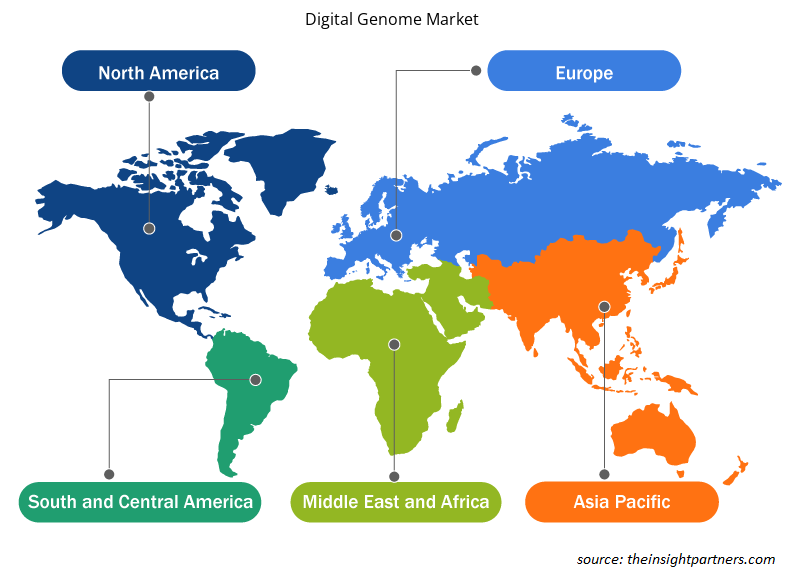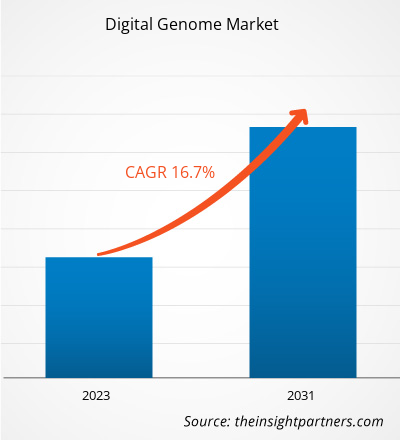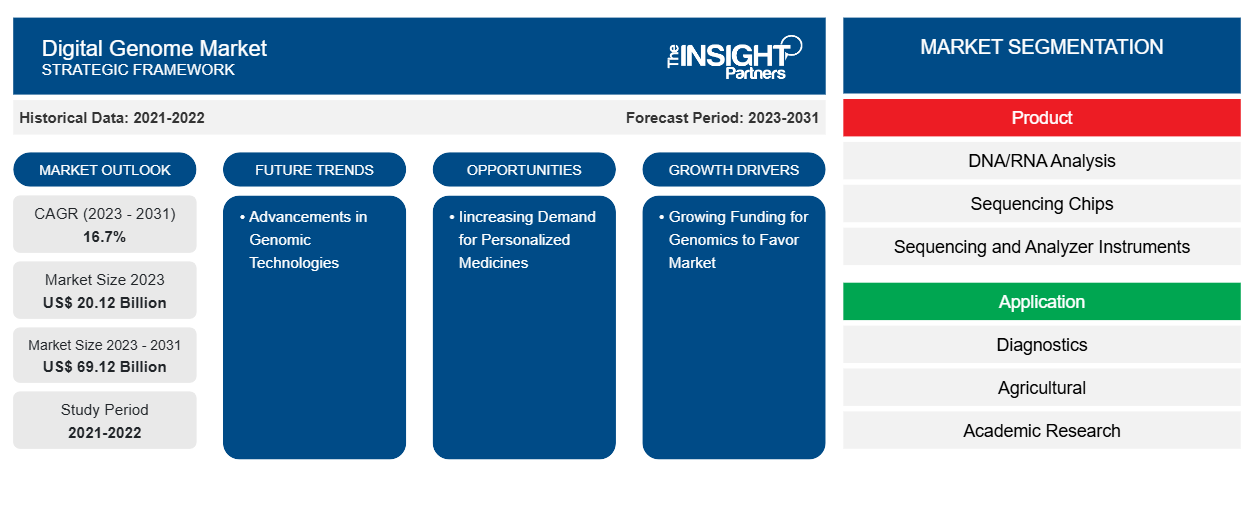Se prevé que el tamaño del mercado del genoma digital alcance los 69.120 millones de dólares en 2031, frente a los 20.120 millones de dólares en 2023. Se espera que el mercado registre una CAGR del 16,7 % entre 2023 y 2031. Es probable que la creciente demanda de medicamentos personalizados siga siendo una tendencia clave en el mercado del genoma digital.
Análisis del mercado del genoma digital
Las enfermedades crónicas como la diabetes, las enfermedades cardíacas , los accidentes cerebrovasculares, el cáncer y la obesidad son las principales causas de muerte en el mundo y representan la mayor parte de los costos de atención médica del país. Según el informe del Atlas de la Diabetes de la FID publicado en 2021, 537 millones de adultos viven con diabetes y se proyecta que la cifra aumente a 643 millones en 2030 y a 783 millones en 2045. Además, la creciente población geriátrica y las enfermedades crónicas relacionadas también impulsarán el crecimiento del mercado del genoma digital durante el período de pronóstico.
Panorama del mercado del genoma digital
Los institutos de investigación llevan a cabo numerosos proyectos y estudios para descubrir y estudiar diferentes aspectos, características y aplicabilidad del genoma digital en los campos médicos. Los institutos de investigación y los centros académicos muchas veces entran en colaboraciones con las empresas privadas para desarrollar terapias innovadoras para el tratamiento de enfermedades. Además, se proyecta que un número cada vez mayor de inversiones en programas de investigación impulsará el crecimiento del segmento. Recientemente, Illumina ofrece subvenciones y patrocinios para apoyar la investigación que se alinea con la misión de deshacer el poder del genoma e impulsar el progreso de la genómica . Los beneficios y la precisión que ofrecen las cirugías mínimamente invasivas impulsan el crecimiento del mercado del genoma digital.
Personalice este informe según sus necesidades
Obtendrá personalización en cualquier informe, sin cargo, incluidas partes de este informe o análisis a nivel de país, paquete de datos de Excel, así como también grandes ofertas y descuentos para empresas emergentes y universidades.
- Obtenga las principales tendencias clave del mercado de este informe.Esta muestra GRATUITA incluirá análisis de datos, desde tendencias del mercado hasta estimaciones y pronósticos.
Factores impulsores y oportunidades del mercado del genoma digital
El aumento de la financiación de la genómica favorece el mercado
La secuenciación genómica está pasando rápidamente a la práctica clínica y una inversión gubernamental sustancial ha apoyado su implementación en los sistemas de atención médica. Por ejemplo, en marzo de 2024, el Proyecto Genoma de la India, financiado y coordinado por el Departamento de Biotecnología, anunció que había terminado de secuenciar 10.000 genomas indios. Los genomas completos, es decir, el modelo de ADN que constituye y mantiene los cuerpos humanos, se analizaron a partir de 10.000 individuos para crear un genoma humano indio de "referencia". Se espera que el mercado del genoma digital crezca durante el período de pronóstico debido a la financiación de los fabricantes y el gobierno en el campo de la genómica. sequencing is rapidly transitioning into clinical practice, and substantial government investment has supported implementation into healthcare systems. For instance, in March 2024, The Genome India Project, funded and coordinated by the Department of Biotechnology, announced they had finished sequencing 10,000 Indian genomes. The completed genomes, i.e., the DNA blueprint constituting and maintaining human bodies was analyzed from 10,000 individuals to create a ‘reference’ Indian human genome. The digital genome market is expected to grow during the forecast period due to funding from manufacturers and the government in the field of genomics.
Avances en las tecnologías genómicas: una oportunidad en el mercado del genoma digitalGenomic Technologies – An Opportunity in Digital Genome Market
Los avances sin precedentes en la investigación y las tecnologías genómicas han creado el potencial de transformación en los sectores de la atención médica y las ciencias biológicas. Las aplicaciones clínicas de las tecnologías genómicas son infinitas y ofrecen oportunidades para mejorar las capacidades de diagnóstico y tratamiento de enfermedades crónicas. Por ejemplo, ofrecen un enorme potencial en el descubrimiento de genes y el diagnóstico de trastornos monogénicos raros. Las tecnologías genómicas también se utilizan para diagnosticar a personas con errores genéticos de alto riesgo que conducen a enfermedades raras. Además, las tecnologías genómicas se utilizan cada vez más para analizar factores genéticos raros y comunes. Por ejemplo, en abril de 2020, Personal Genome Diagnostics recibió la aprobación de la Administración de Alimentos y Medicamentos (FDA) para la prueba completa de tejido PGDx elio. Personal Genome Diagnostics (PGDx) elimina las barreras a las pruebas oncológicas de precisión para hacer que los tratamientos oncológicos personalizados y oportunos sean una realidad para todos.
Análisis de segmentación del informe de mercado del genoma digital
Los segmentos clave que contribuyeron a la derivación del análisis del mercado del Genoma Digital son el producto, la aplicación y el usuario final.
- Según el producto, el mercado del genoma digital se divide en análisis de ADN/ARN, chips de secuenciación, instrumentos de secuenciación y análisis, instrumentos de preparación de muestras y software de secuenciación y análisis. El segmento de instrumentos de secuenciación y análisis tuvo una mayor participación de mercado en 2023.
- Según la aplicación, el mercado se segmenta en agricultura, diagnóstico, investigación académica, medicina personalizada, descubrimiento de fármacos y otros. El segmento de diagnóstico tuvo una mayor participación de mercado en 2023.
- En términos de usuario final, el mercado está segmentado en institutos de investigación académica, laboratorios de diagnóstico y forenses, hospitales y otros. El segmento de laboratorios de diagnóstico y forenses dominó el mercado en 2023.
Análisis de la cuota de mercado del genoma digital por geografía
El alcance geográfico del informe de mercado del genoma digital se divide principalmente en cinco regiones: América del Norte, Europa, Asia Pacífico, Oriente Medio y África, y América del Sur y Central. El mercado del genoma digital en América del Norte es significativo. En América del Norte, el crecimiento del mercado del genoma digital está impulsado principalmente por las tecnologías de detección rápida, la creciente preferencia por la medicina personalizada, el alto gasto en I+D para productos terapéuticos y la presencia de actores líderes del mercado en los EE. UU. que acelerarán el crecimiento de este mercado en este país. Por ejemplo, en marzo de 2024, la empresa estadounidense Nucleus Genomics anunció el lanzamiento de su producto de análisis de ADN para llevar los beneficios de la medicina personalizada a todos. Se espera que los factores anteriores afecten positivamente al crecimiento del mercado del genoma digital.
Perspectivas regionales del mercado del genoma digital
Los analistas de Insight Partners explicaron en detalle las tendencias y los factores regionales que influyen en el mercado del genoma digital durante el período de pronóstico. Esta sección también analiza los segmentos y la geografía del mercado del genoma digital en América del Norte, Europa, Asia Pacífico, Oriente Medio y África, y América del Sur y Central.

- Obtenga datos regionales específicos para el mercado del genoma digital
Alcance del informe sobre el mercado del genoma digital
| Atributo del informe | Detalles |
|---|---|
| Tamaño del mercado en 2023 | US$ 20,12 mil millones |
| Tamaño del mercado en 2031 | US$ 69,12 mil millones |
| CAGR global (2023 - 2031) | 16,7% |
| Datos históricos | 2021-2022 |
| Período de pronóstico | 2023-2031 |
| Segmentos cubiertos | Por producto
|
| Regiones y países cubiertos | América del norte
|
| Líderes del mercado y perfiles de empresas clave |
|
Densidad de actores del mercado del genoma digital: comprensión de su impacto en la dinámica empresarial
El mercado del genoma digital está creciendo rápidamente, impulsado por la creciente demanda de los usuarios finales debido a factores como la evolución de las preferencias de los consumidores, los avances tecnológicos y una mayor conciencia de los beneficios del producto. A medida que aumenta la demanda, las empresas amplían sus ofertas, innovan para satisfacer las necesidades de los consumidores y aprovechan las tendencias emergentes, lo que impulsa aún más el crecimiento del mercado.
La densidad de actores del mercado se refiere a la distribución de las empresas o firmas que operan dentro de un mercado o industria en particular. Indica cuántos competidores (actores del mercado) están presentes en un espacio de mercado determinado en relación con su tamaño o valor total de mercado.
Las principales empresas que operan en el mercado del genoma digital son:
- TERMOFISHER CIENTIFIC INC.
- F.HOFFMANN-LA ROCHE LTD
- Ilumina, Inc.
- QIAGEN
- GenomeMe Inc.
- Tecnologías NanoString, Inc.
Descargo de responsabilidad : Las empresas enumeradas anteriormente no están clasificadas en ningún orden particular.

- Obtenga una descripción general de los principales actores clave del mercado del genoma digital
Noticias y desarrollos recientes del mercado del genoma digital
El mercado del genoma digital se evalúa mediante la recopilación de datos cualitativos y cuantitativos a partir de investigaciones primarias y secundarias, que incluyen publicaciones corporativas importantes, datos de asociaciones y bases de datos. A continuación, se incluye una lista de los avances en el mercado en materia de innovaciones, expansión comercial y estrategias:
- En enero de 2023, QIAGEN Digital Insights (QDI) lanzó QIAGEN CLC Genomics Workbench Premium, que elimina el cuello de botella del análisis de datos de la secuenciación de próxima generación (NGS) al analizar e interpretar la secuenciación del genoma completo (WGS), los datos de secuenciación de paneles grandes y la secuenciación del exoma completo (WES). (Fuente: QIAGEN, comunicado de prensa)
- En agosto de 2022, Mount Sinai Health System y la Icahn School of Medicine lanzaron un nuevo proyecto de investigación de secuenciación del genoma humano denominado Mount Sinai Million Health Discoveries Program con el Regeneron Genetics Center (RGC). El objetivo es proporcionar un conjunto de datos único a los investigadores que los ayude a evaluar el verdadero potencial de los enfoques de medicina de precisión basados en la genética para orientar la atención diaria de los pacientes. (Fuente: Mount Sinai Health System, boletín informativo)
Cobertura y resultados del informe sobre el mercado del genoma digital
El informe “Tamaño y pronóstico del mercado del genoma digital (2021-2031)” proporciona un análisis detallado del mercado que cubre las siguientes áreas:
- Tamaño del mercado del genoma digital y pronóstico a nivel global, regional y nacional para todos los segmentos clave del mercado cubiertos bajo el alcance
- Dinámica del mercado, como impulsores, restricciones y oportunidades clave
- Tendencias del mercado del genoma digital
- Análisis PEST y FODA detallados
- Análisis del mercado del genoma digital que abarca las tendencias clave del mercado, el marco global y regional, los principales actores, las regulaciones y los desarrollos recientes del mercado
- Panorama de la industria del genoma digital y análisis de la competencia que abarca la concentración del mercado, el análisis de mapas de calor, los actores destacados y los desarrollos recientes
- Perfiles detallados de empresas
- Análisis histórico (2 años), año base, pronóstico (7 años) con CAGR
- Análisis PEST y FODA
- Tamaño del mercado, valor/volumen: global, regional y nacional
- Industria y panorama competitivo
- Conjunto de datos de Excel
Informes recientes
Informes relacionados
Testimonios
Razón para comprar
- Toma de decisiones informada
- Comprensión de la dinámica del mercado
- Análisis competitivo
- Información sobre clientes
- Pronósticos del mercado
- Mitigación de riesgos
- Planificación estratégica
- Justificación de la inversión
- Identificación de mercados emergentes
- Mejora de las estrategias de marketing
- Impulso de la eficiencia operativa
- Alineación con las tendencias regulatorias





















 Obtenga una muestra gratuita para - Mercado del Genoma Digital
Obtenga una muestra gratuita para - Mercado del Genoma Digital